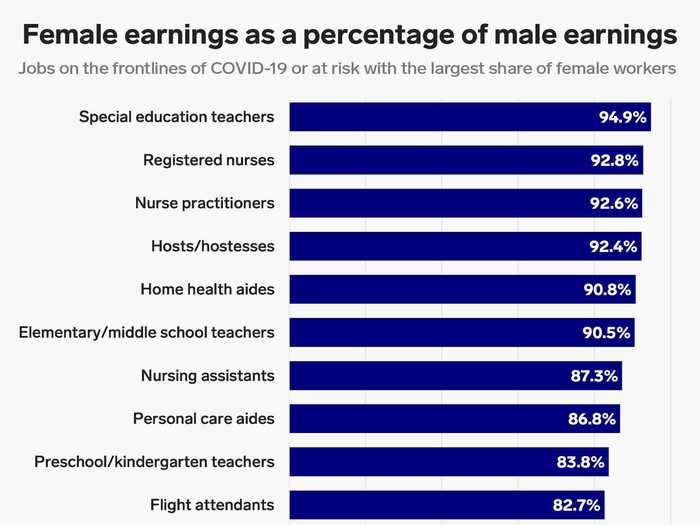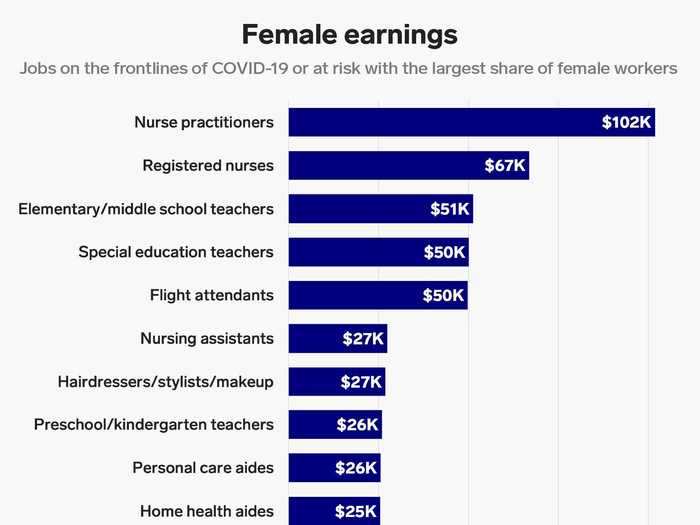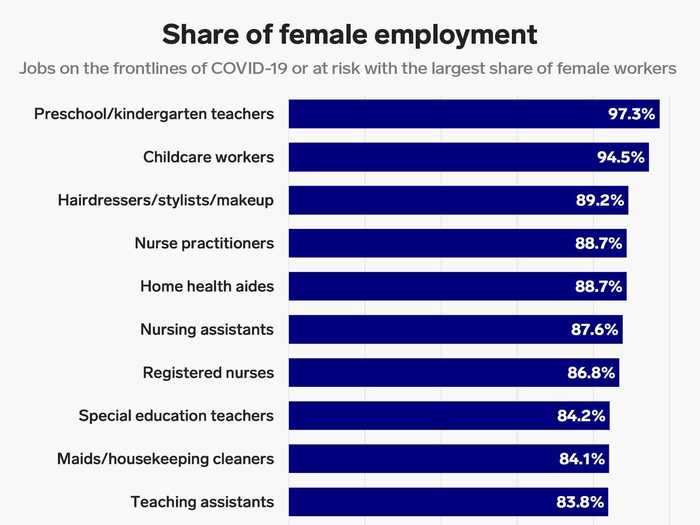Women are the front-line soldiers in the battle against coronavirus — but we're still not paying them as much as men
Madison Hoff
- The novel coronavirus has caused economic chaos in the US.
- Women make up a large share of the labor force on the front lines of the coronavirus and in industries and occupations that have taken particularly large hits during the pandemic.
- Using Census Bureau data, we compiled a list of detailed occupations affected by the coronavirus and compared female earnings and employment to those of male workers in these jobs.
- 14 of the jobs on our list had women making up at least 75% of the workforce, and women earned less than men in these occupations.
- We created three charts that highlight the pay gap and how women in these 14 jobs could be financially affected by the coronavirus.
- Visit Business Insider's homepage for more stories.
Although recent data shows more men are dying from the novel coronavirus than women, women could be more financially impacted than men by the economic fallout caused by the outbreak. Women make up a large share of the labor force in jobs and industries that have had job cuts and layoffs in the past few weeks, as well as occupations on the front lines of the pandemic.
Workers like waitresses, restaurant cooks, and hotel clerks in the leisure and hospitality industry have especially been affected by the coronavirus. The industry lost around 459,000 jobs in March — the most job losses out of any US industry so far. It is important to note that those reported job figures are from the first two weeks of March, so the number of job losses is likely to be far higher, as layoffs across the US have continued at a rapid pace since then.
Not only are these women putting their own health at risk by working in these positions during a pandemic or trying to manage work with other family responsibilities, they also aren't earning as much as their male counterparts in these professions.
According to a Fortune article for March 31's Equal Pay Day, the pay gap "worsens" the coronavirus' financial impact for women.
Business Insider decided to take a closer look at jobs especially affected by the coronavirus outbreak in which females make up a large share of the labor force and examine the pay gap in these professions.
We considered 53 occupations on the front lines, including jobs in leisure and hospitality that have experienced the most layoffs in the last few weeks, jobs in healthcare treating coronavirus and other patients, and other jobs affected by the coronavirus like teachers. After compiling this list, we focused on the 14 occupations where at least 75% of the labor force was female in 2018.
We used 2018 data, the most recent available, from the US Census Bureau's American Community Survey on female earnings and employment and male earnings from full-time, year-round workers in those occupations who were age 16 or over.
According to the Census data, women made up 87% of registered nurses and 71% of cashiers. However, female nurses earned just 93% of what male nurses make and female cashiers earned 89% of the typical wages of male cashiers. Waitresses, who have seen a massive wave of layoffs as restaurants and bars temporarily close, made up 65% of restaurant servers, earning 81% of what male waiters make.
Compensation software company PayScale has conducted their own analysis of the gender pay gap and how the coronavirus can exacerbate it. The company has analyzed the US gender pay gap for the past five years.
In this year's report, the company found women in 2020 make 81 cents for every dollar a man makes. When controlling for different factors that influence pay, such as years of job experience, what PayScale called "the controlled pay gap," the company found the gap in 2020 was 98 cents for every dollar a man makes.
"So that's 2% that a female version of me is losing because they're a female, not because of anything else," Director of Research Sudarshan Sampath of PayScale told Business Insider.
In addition to working on the front lines of the pandemic or even just working from home, women are more likely to have to balance work with caring for a sick or elderly family member during the pandemic.
"A lot of women not only are expected to go and work, but they have to come home and take care of their kids too or take care of their family," Sampath said.
Even after the coronavirus pandemic, women who have taken time off or found themselves out of work will likely find a pay penalty just for leaving the workforce. Based on a previous pay gap analysis by PayScale, people who leave the workforce and come back to a new job will receive an offer 7% less than someone currently working in the same kind of position. PayScale said because women are more likely to leave work to take care of family during the coronavirus, they are more likely to see this pay penalty.
"Just the fact that they left their jobs and they're coming back into an unequal workforce, and you're asking them to lose 7% on top of that, that is just a huge impact on the economy overall," Sampath said. "50% of the workforce is women. We don't think about them enough, and that's a huge source of economic loss just generally."
The following three charts take a closer look at occupations on our list of jobs affected by the coronavirus where women made up at least 75% of the labor force. We compared how much female workers earned in 2018 compared to men in the same job:
Read the original article on Business InsiderREAD MORE ARTICLES ON
Popular Right Now
Popular Keywords
Advertisement



